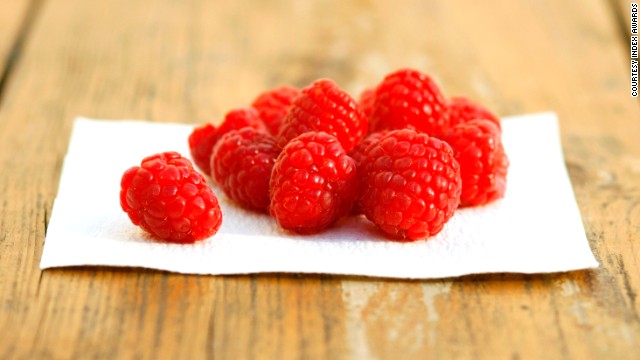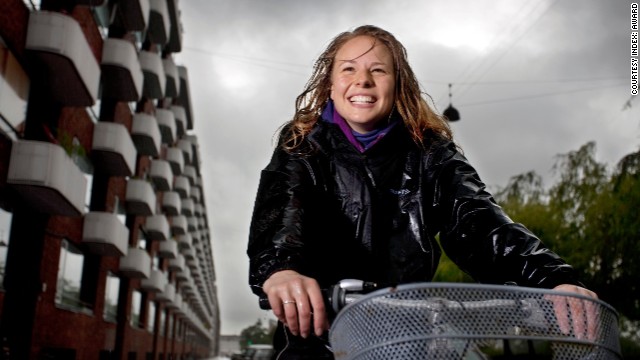
STORY HIGHLIGHTS
- Culinary scientists are encouraging people to reduce poverty by eating insects
- Grasshoppers and caterpillars could soon be seen on menus worldwide
- Other futuristic foodstuffs include ‘meat analogues,’ which are made from plant based proteins
Editor’s note: Every two years, the prestigious INDEX: Award seeks out designers working on innovative solutions to global challenges. In this special CNN series, we profile a selection of the nominees and winners.
(CNN) — With 7.1 billion mouths to feed, and plenty more on the way, the world needs to find new ways to feed its citizens. Growing more of our own food, even in the smallest city apartments, may be part of the solution, but we may also need to get a little more adventurous — and a little less squeamish — when writing our menus.
Caterpillar and chive pate, grasshopper mousse and plant-based “meat analogues” may all make an appearance on the dinner plate of the future. These are just some of the products and concepts that could change our diets beyond recognition, according to the nominees for this year’s INDEX: Award, which seek creative responses to urgent global challenges.
One such challenge is the soaring demand for meat. It starts with a good news story: more and more people lifting themselves out of poverty. As they do, many also shun the frugal vegetarianism of their old lives in favor of the protein-rich diet of the wealthy West. In turn, that leads to the increased water use and greenhouse gas production associated with intensive livestock farming.
I could never reconcile the notion that one side of the world had so much to eat when the other had so little.
Mansour Ourasanah, LEPSIS creator
Read more: Could insects soon become part of our diet?
A bug’s life
Mansour Ourasanah may have part of the solution: LEPSIS – a sleek and self-contained grasshopper colony you can keep on your kitchen windowsill. He began work on the design after moving from Togo to New York City, where he was appalled by how much food was wasted.
 Microcomputer Raspberry Pi took home the Play Award, with judges praising the $25 device for “democratizing coding.”
Microcomputer Raspberry Pi took home the Play Award, with judges praising the $25 device for “democratizing coding.” INDEX: Award 2013 winners
INDEX: Award 2013 winners
INDEX: Award 2013 winners
INDEX: Award 2013 winners
INDEX: Award 2013 winners
HIDE CAPTION
<<
<</span>
>
>>
 INDEX: Award 2013 winners
INDEX: Award 2013 winners “I could never reconcile the notion that one side of the world had so much to eat when the other had so little,” he told CNN. “As a New Yorker I was also part of the problem. I over-consumed and wasted my fair share of food.”
He began to change his diet, cutting back on meat and trying to reduce waste, “but as a designer I always knew I could do more,” he said. Inspiration struck when he remembered the plentiful, free protein he and his siblings used to find in west Africa.
“As a Togolese child, eating insects was an integral part of our diet during rainy seasons,” he said. “On days when we didn’t have enough to eat at home, we looked for grasshoppers and crickets.”
Ento also seeks to promote what it calls “the art of eating insects”. Conscious of resistance from many western diners, the London-based designers have come up with a platter of creepy-crawly canapes whose insect origins are not immediately apparent. Caterpillar pate and grasshopper mousse, for example, are formed into appetizing cubes and rolled into sesame seeds. The aesthetics are little different from sushi — another dish once viewed skeptically by western diners.
Watch: Eating insects is healthy
 How a thin piece of paper can save lives
How a thin piece of paper can save lives
So how would Mikal Hallstrup, a partner at the Designit design agency in Denmark and chairman of the awards jury, react to seeing insects on the menu? “I’d love it,” he told CNN. “At Noma in Copenhagen they have ants on the menu. They’re supposed to taste delicious, a bit acidic. … Grasshoppers, like houseflies, grow exceptionally fast. Not only are they healthier sources of protein, they are environmentally significantly less taxing than other meat production. So, why not?”
 Food delivery to your gate
Food delivery to your gate
Paola Antonelli, a senior curator of design at the Museum of Modern Art in New York and another jury member, was similarly open to experimentation. “I have eaten grasshoppers — fried, chocolate-covered, and otherwise candied — bees, and worms,” she said, “and I am ready to eat them again any time, so long as they are yummy. So far, I loved the fried bees the most and the chocolate-covered grasshoppers the least. I’d rather eat insects as crustaceans, not as candy.”
Animal-friendly meat
 Would you try a breast-milk lollipop?
Would you try a breast-milk lollipop?
Less open-minded protein junkies may prefer the approach of Beyond Meat and Like Meat, who have developed what they call “meat analogues”, the less-than-appetizing term for plant-based proteins with the texture, taste and appearance of meat.
Ethan Brown, the founder and CEO of Beyond Meat, said the most sensitive foodie palettes had been fooled by his company’s chicken substitute, which provides “all the protein, taste, chew and enjoyment of chicken without any antibiotics, hormones, GMOs, saturated fat or cholesterol.”
Whatever we choose to eat, we may soon be expected to take far more responsibility for growing our own food. Even if you’re not yet ready for a grasshopper colony in your kitchen, you could take a small step towards self-sufficiency with the high-design Windowfarm, an elegant, multi-storey hydroponic herb garden. It may not feed a hungry family, but you’ll never be short of a sprig of basil for your fresh pesto.
Read more: Edible wrapping tastes as good as what’s inside
Future farms
That may seem like a baby step towards self-sufficiency, but another nominee enables bigger strides. The Boston-based team behind FreightFarms takes old shipping containers and turns them into modular, stackable urban farms for parking lots, garages or unused land. Each crate is fitted out with climate-control and hydroponic systems for maximum yield and energy efficiency. According to the designers, a single container can nurture 3,000 plants at any one time, more than matching the output of a traditional agricultural greenhouse.
After spending most of high school meticulously rotting fruits and vegetables, I developed FreshPaper.
Kavita Shukla, FreshPaper creator
Producing food nearer to where it will be consumed would cut the carbon and energy expended in transporting and refrigerating produce, but there’s an even simpler way to improve the efficiency of the world’s food ecosystem.
According to the Institution of Mechanical Engineers, between 30% and 50% of the world’s food is thrown away rather than eaten — which means that a third to a fifth of the energy, water and effort that goes into food production is wasted.
Correcting that failure will require systemic changes, but individual consumers can play their part too. Two other nominees provide simple, small-scale ways to keep produce fresh and cut the amount of food that ends up rotting on the refuse heap. FreshPaper, a sheet of paper impregnated with organic spices and enzymes with natural anti-fungal and antibacterial properties, claims to double or even quadruple the life of fruit and veg.
‘;
document.write(OB_MarkUP);
if (typeof(OB_Script)!=’undefined’)
OutbrainStart();
else{
var OB_Script=true;
var str=”
Taken from:
Grow your own to feed the world
The post Grow your own to feed the world appeared first on Arne Ruhnau News.
via Arne Ruhnau News http://arneruhnau.com/grow-your-own-to-feed-the-world/
 New invention Fresh Paper makes fruit and vegetables last two to four times longer using natural spices. Judges chose it for the Home Award complimenting its simple response to the global issue of food shortage.
New invention Fresh Paper makes fruit and vegetables last two to four times longer using natural spices. Judges chose it for the Home Award complimenting its simple response to the global issue of food shortage.  The winner in the Body category, Natalie Collection, is a trio of devices which aim to prevent neonatal asphyxia. Judges chose it for the impact it is already making.
The winner in the Body category, Natalie Collection, is a trio of devices which aim to prevent neonatal asphyxia. Judges chose it for the impact it is already making.  INDEX’s home city Copenhagen took one of two Community Awards given this year for its Climate Adaptation Plan. Judges praised Copenhagen for envisioning “a vibrant and resilient habitat for the 21st century.”
INDEX’s home city Copenhagen took one of two Community Awards given this year for its Climate Adaptation Plan. Judges praised Copenhagen for envisioning “a vibrant and resilient habitat for the 21st century.”  Intelligent road concept Smart Highway became INDEX’s first double award winner, taking the second Community Award and the People’s Choice Award — as voted for by readers of CNN.com. The jury applauded the reinvention of “dumb” roads for the 21st Century.
Intelligent road concept Smart Highway became INDEX’s first double award winner, taking the second Community Award and the People’s Choice Award — as voted for by readers of CNN.com. The jury applauded the reinvention of “dumb” roads for the 21st Century. 




No comments:
Post a Comment